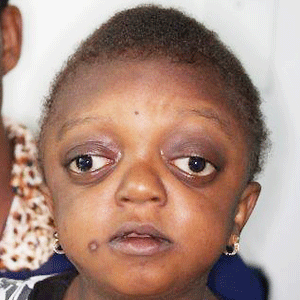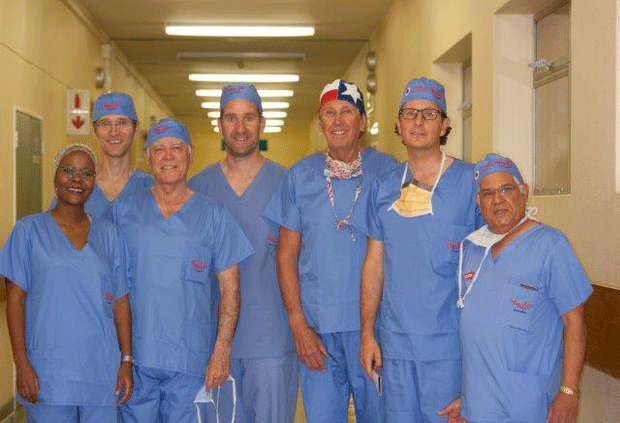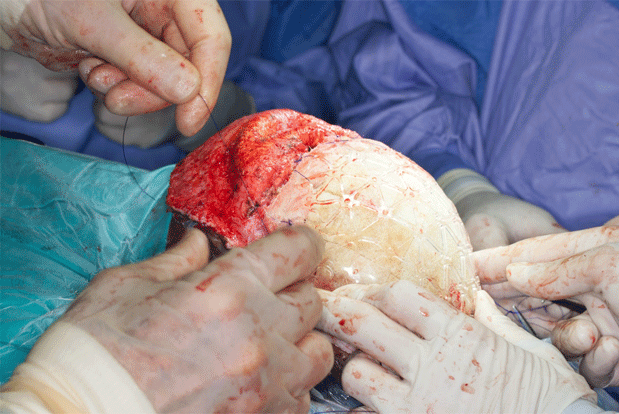
Professor Frank Graewe, the micro-surgeon who was part of the team who performed the world’s first successful penile transplant, has teamed up with the World Craniofacial Foundation and Smile Foundation SA to help give normal lives to two African girls with serious skull defects.
The international teams utilised advanced 3D printing technology in order to prepare for the gruelling surgeries.
Image: Surgeons from left to right: Dr. Mosadi Mahoko, Dr. Alexander Zuhlke, Dr. Derek Bruce, Dr. Christiaan Gildenhuis, Dr. Salyer, Prof. Frank Graewe, Prof. Bennie Hartzenberg, Tygerberg Hospital.

Grace, a seven-year-old girl from Zambia, was born with her eyes extremely wide apart and with no bone separating her brain from her oral cavity. Last year, after extensive craniofacial surgery in Mexico City, she developed a severe postoperative infection.
The infection left her with a serious bony skull defect which, without further surgical intervention, would have forced her to wear a helmet and constant protective gear for the rest of her life.
The World Craniofacial Foundation (WCF) facilitated bringing her to Cape Town to be treated by Professor Graewe and a team of visiting WCF surgeons at the Tygerberg Academic Hospital.
Image: Grace before and after her initial surgery and, far right, before her most recent surgery. Source: Facebook

You can see her progress on Facebook
Akikere, a six-year-old from Nigeria (pictured top right), suffers from Crouzon syndrome, a genetic disorder characterised by the premature fusion of the skull bones and cranial base. The surgery was needed to improve an upper airway respiratory obstruction and to improve intracranial pressure and the shape of Akikere’s skull.
Image: Artificial bony structure being secured to the skull

“Neither of these patients would have been able to lead a normal life without these surgeries and both patients are recovering well,” says Graewe. “I sit on the advisory board of the WCF and have a longstanding relationship with the organisation and its founder.
"The WCF were looking for a reliable unit to conduct the surgeries, and I was happy to put our team forward."
Each patient was initially admitted to Tygerberg Academic Hospital, where CT images were made of their skulls, then sent to the USA where models of the skulls were made with 3D printers. In Grace’s case, the model of her head was critical in the manufacture of an artificial bony structure that, over time, will be transformed into natural bone.
Image: The artificial bony structure

Incredible expertise and passion
Few patients in the world with such a massive skull defect have ever been successfully treated, and her future now looks bright.
The materials for the modelling and framework alone cost about R875,000 ($70,000), and without funding from the Smile Foundation SA and the WCF, the surgeries could not have taken place.
Assisting Professor Frank Graewe in both surgeries were Dr Kenneth Salyer, the Founder and Chairman of the World Craniofacial Foundation, and two neurosurgeons, Professor Bennie Hartzenberg, the Chief Neurosurgeon at Tygerberg Academic Hospital, and Dr Derek Bruce a paediatric neurosurgeon from Washington.
“As chairman of the WCF,” says Dr Sayler, “I am thrilled that these surgeries were performed here in South Africa. The expertise and passion that the team showed was incredible and we are very happy with the progress of our young patients.”
The two surgeries took the team, who offered their time and expertise free of charge, alltogether eleven hours to complete and both patients are doing well. Grace has returned to Zambia and Akikere is recovering well at Tygerberg Academic Hospital.
“We need to push the limits and boundaries of technological advancements to ensure that patients with these types of defects have the best possibility of leading a normal life,” says Dr Bruce.
“Our work on Grace’s case was groundbreaking, and we are very pleased that we were able to utilise 3D printing in order to bioengineer bone for the surgery.”
Image: The surgeons at work

To make a donation to the Smile Foundation SA, please visit their website www.smilefoundationsa.org, and for the WCF go online to .
Read more:
World first: penis successfully transplanted in Cape Town
SA's first 3D-printed jaw bone implantation a success
Lifelike ears created with 3D printing




 Publications
Publications
 Partners
Partners











